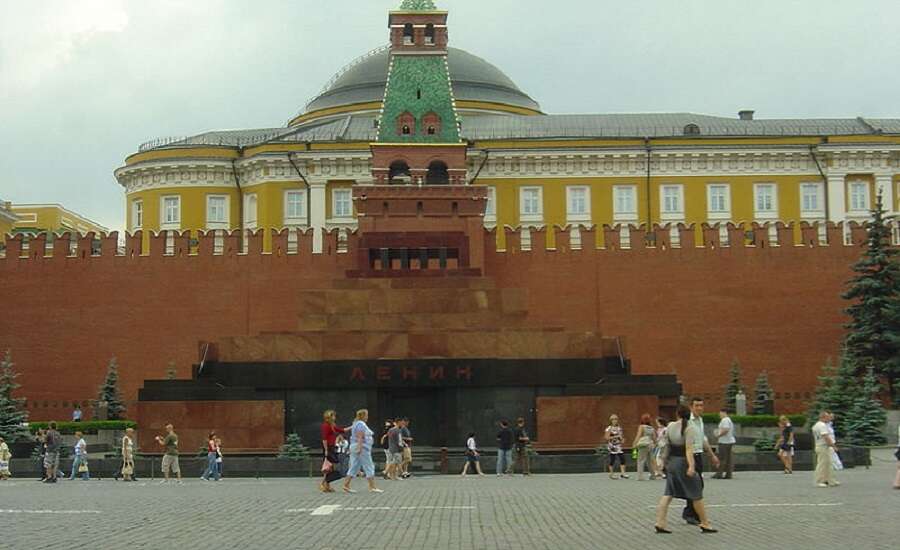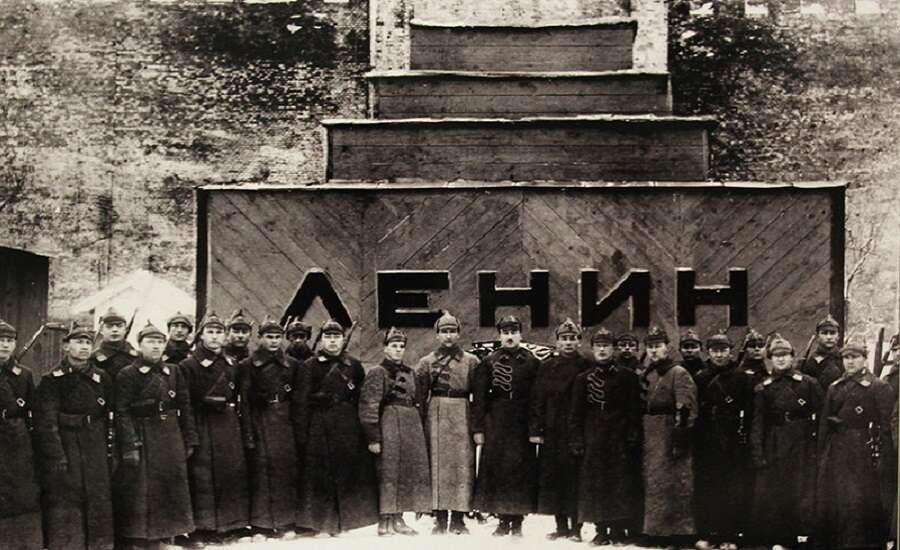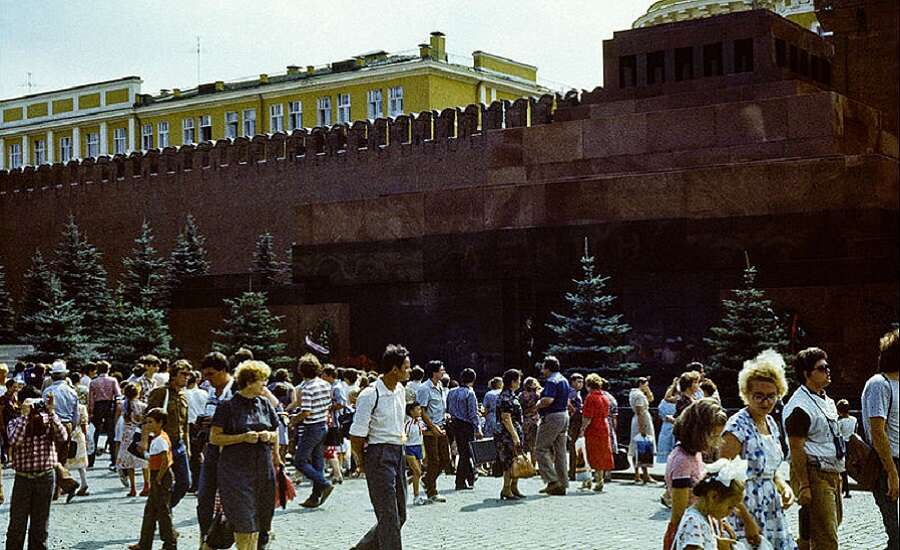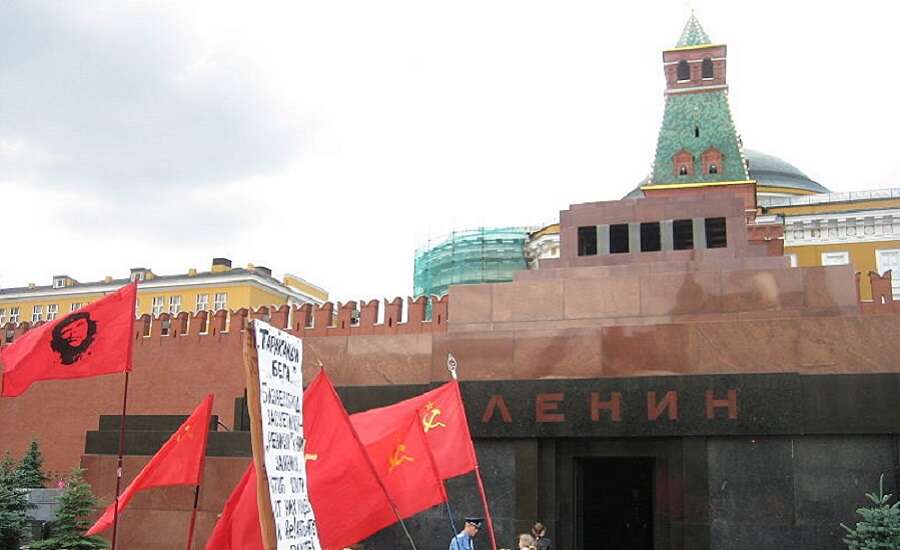Lenin’s Mausoleum is one of Red Square’s most macabre but most popular attractions that you may visit during your tour to Russia. Since his death in January 1924, the leader of the October Revolution has lay embalmed in Russia’s capital and can be visited to this day, offering a glimpse of the revered place that he held in Soviet politics and society.

Photo by DIMSFIKAS on Wikipedia
A cult of personality surrounded Vladimir Lenin, which practically evolved into a new religion for the proletariat. As Lenin fell gravely ill in 1922, efforts were increased to cement the mythical image of the Father of the October Revolution, and a new term, ‘Leninism’ was introduced in 1923 to place Lenin at the centre of Soviet ideology.
Vladimir Lenin died on 21st January 1924, and nationwide mourning began immediately. His body was temporarily embalmed before his funeral on 27th January, so that people could pay their respects. Although Lenin wanted to be buried, the Soviet government received 10,000 telegrams begging for his body to be preserved for posterity, almost as a relic to accompany his quasi-religious image. The embalming of Lenin’s body was the will of his successors too. The physical presence of Lenin in the very heart of the USSR would represent the eternality of Soviet power, and until the collapse of the Soviet Union, adaptations of the doctrines of Leninism allowed Soviet leaders to justify their decisions and condemn those who opposed them. Lenin’s body was placed in the mausoleum later that year.
Did you know? Lenin’s brain was removed from his body and moved to the Brain Institute. His brain was cut into 30,000 sections placed between glass plates, which are still preserved to this day.
The first mausoleum was constructed for the day of Lenin’s funeral by Alexei Shushchev, in the form of a wooden cube crowned with a three-tier pyramid. The second version was built in the spring of 1924, and a sarcophagus designed by Konstantin Melnikov was added. The third and final mausoleum, constructed between 1929 and 1930 by Shushchev, was made from concrete with brick walls, a granite façade, and decorated with labradorite, marble and raspberry quartzite.

Photo by image1.org on Wikipedia
Did you know? In the 1930s, there were repeated rumours in the foreign media that Lenin’s body was not real. Consequently, representatives of the Western press were invited to Moscow to see that the body was in fact not a wax figure.
With the outbreak of the Great Patriotic War in July 1941, Lenin’s body was evacuated to Tyumen in Siberia, and the mausoleum was disguised as a mansion to protect it from German bombers. From 1945 until 1995, members of the Soviet government used Lenin’s Mausoleum as a stage to observe the 9th May Victory Day Parade on Red Square. Following his death in 1953, Stalin was interred in the mausoleum, which was renamed ‘The Mausoleum of Lenin and Stalin’. His body was removed in 1961 as part of the process of Destalinisation, and placed in the Kremlin Wall Necropolis.

Photo by Thomas Münter on Wikipedia
Following the collapse of the Soviet Union, the image of Lenin as the canonical symbol of the country was no more. Funding to the mausoleum was cut, and the post of the honorary guard which stood by the tomb was abolished. Discussions took place over whether Lenin’s body should be removed and reburied, an opinion expressed by President Boris Yeltsin and the mayors of St Petersburg and Moscow, Anatoly Sobchak and Yuri Luzhkov. This was not carried out, as Red Square and its ensemble had been recognised as a UNESCO World Heritage Site in 1990, and Lenin’s Mausoleum remained a significant historical and cultural monument despite the ideological and political changes which had taken place.
The divisive debate continues to this day. In 2012, Vladimir Putin expressed that there was no plan to remove Lenin from the mausoleum. However, in April 2017, a number of Duma Deputies proposed to the State Duma that Lenin’s reburial should be reconsidered and his mausoleum relocated, as Lenin is not a symbol of modern Russia. At the same time, a survey conducted by the All-Russian Centre for the Study of Public Opinion revealed that 60% of Russians approved of Lenin’s reburial, although 24% of them believed that this should not be carried out until the last Soviet generation has passed.
Did you know? There have been several violent incidents in Lenin’s Mausoleum, including an attempt to shoot Lenin in 1934, a visitor launching a hammer at Lenin in 1959, and two bombings in 1960 and 1973.

Photo by Zinneke on Wikipedia
Lenin’s Mausoleum remains one of Red Square’s most popular sites, attracting over 2.5 million visitors annually. To enter the mausoleum, visitors must assemble near the Kremlin’s Nikolskaya Tower before passing through the security checkpoint and metal detector. Photo and video equipment, mobile telephones, large bags, and bottles must be stored in a locker.
Did you know? Although there is no longer an honorary guard at Lenin’s Mausoleum, the post has been re-established since December 1997 at the Tomb of the Unknown Soldier in the Alexander Garden adjoining the Kremlin. The changing of the guard happens every hour at the signal of the Kremlin bells.
After descending a wide staircase you will enter the mourning hall, a 10x10-metre cube decorated with labradorite, red porphyry, and red smalt. The mausoleum is kept at a constant temperature of 16°C. Inside a bulletproof glass sarcophagus lies Lenin, dressed in a dark suit. Visitors have only a few minutes inside, and must continuously move through the hall under the watchful eyes of the mausoleum guards. The mausoleum retains its reverent atmosphere: talking, wearing hats, and putting your hands in your pockets is forbidden, as is photography; if you take photos, the staff have the right to examine your camera and delete them.
Did you know? There is a bomb-proof laboratory located under the mausoleum to continue the embalming process. A mild bleach is applied to Lenin’s body every week, and he is re-embalmed every eighteen months. During this time Lenin’s clothes are washed and ironed, and he even receives a new suit every 3 years!
Why not take one of Express to Russia’s Moscow city tours, where our expert and informative guides will show you the best of what Moscow has to offer, including tours of Red Square and its surrounding attractions.
Essential Information for Visitors
Address and contact details
Address: Red Square, Moscow, Russia, 109012
Tel: +7 (495) 623-55-27
Nearest metro: Okhotny Ryad (350m), Ploshchad Revolutsii (500m), Teatralnaya (550m)
Opening Hours
10.00-13.00. Closed on Sundays, Mondays and Fridays.
Entrance to the mausoleum is free: be aware of scammers who will try and charge you for tickets to skip the queue.
Join us on Facebook
We invite you to become a fan of our company on Facebook and read Russian news and travel stories. To become a fan, click here.
Join our own Russian Travel, Culture and Literature Club on Facebook. The club was created to be a place for everyone with an interest in Russia to get to know each other and share experiences, stories, pictures and advice. To join our club, please follow this link.